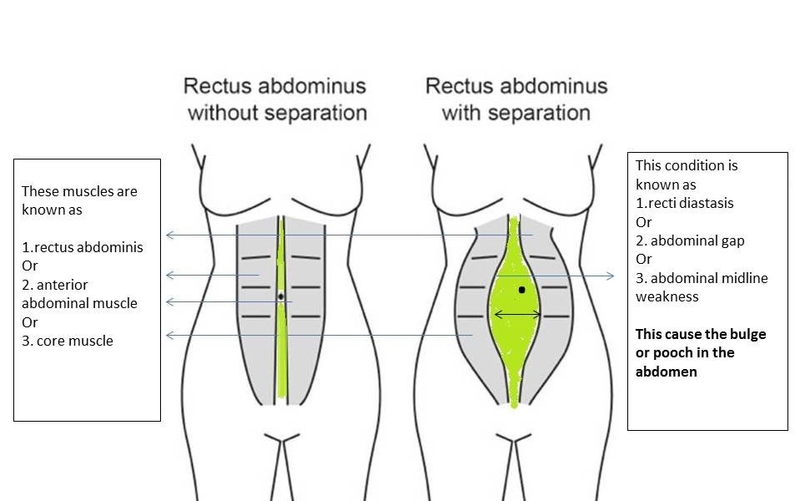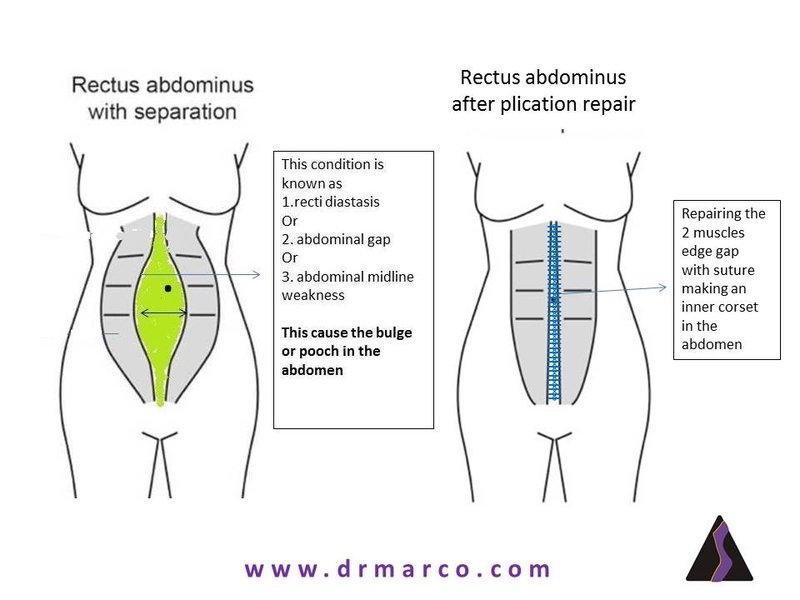Many of us work out in the gym and diet to try to trim and have a flat tummy. Some manage to achieve the results, while some end up with a big bulge like a sausage pumping out in the midline of the abdomen. According to Brazilian Plastic Surgeon Dr Marco Faria-Correa, who practices in Mount Elizabeth Novena Hospital, this bulge can be a rectus diastasis and can lead to many medical conditions.
Do you know what rectus diastasis is?
Rectus diastasis can also be called abdominal separation, abdominal muscle gap, or abdominal midline weakness. It simply means the belly sticks out because the space between the left and right belly muscles has widened, and this causes the bulge or pooch.
It is more common for ladies after pregnancy (part of a mummy makeover ) or in those with a yo-yo weight problem or idiopathic/genetic causes. It can happen to anyone in any age group and to man as well. Being a medical condition, this can be covered by insurance to a certain extent.
Why are our Abdominal Muscles Important?
The anterior abdominal muscle, also known as rectus abdominis, is part of the core muscle group. It is a long vertical muscle that runs down from the body’s midline. It holds our inner organs, such as the bladder, intestines, pelvis, and uterus, in place. It works together with our lower back to help us move our weight around like a stabilizer. Our core muscles give us the foundation to perform movements, maintain balance, and keep flexibility.
What happens if we do not repair the rectus diastasis/bulge?
It can cause an array of problems. Without the dynamic stabilization of the core, it can lead to weakness in the abdominal wall, jeopardizing trunk stability and mobility, contributing to back pain, and compromising posture. It can also result in pelvic floor dysfunctions, hernia, cosmetic defects, and difficult vaginal delivery. Back and pelvic pains are the most common manifestation of a diastasis recti abdominis.
How is it repaired?
According to Plastic Surgeon Dr Marco Faria-Correa, exercise and working out to reinforce all the core muscles help. But if the gap is more than 3cm, the best way to correct the rectus diastasis is with surgery.
The surgical time is estimated from two to four hours, depending on the severity of the diastasis.
There are different ways of performing the surgery to correct the recti diastasis: the open method will include skin removal or abdominal dermo-lipectomy for those with redundant skin fold (also known as abdominal aprons). This method will leave a scar on the bikini line but will tighten the stomach and lift the pubis area giving a flat stomach.
Those presenting with beautiful and non-redundant abdominal skin can use a minimally invasive method known as endoscopic abdominoplasty or endoscopic rectus plication. The latest technology for rectus plication through keyhole incision is the robotic rectus plication or robotic abdominoplasty, which uses the Da Vinci Surgical® system. It leaves a minimal and inconspicuous scar.
What is the Recovery time?
This procedure requires one to three days of stay in the hospital, depending on the individual. The initial recovery is around one to two weeks. Carrying heavy items or returning to regular exercise is recommended around six to eight weeks post-operation.
To learn more about getting that stunning abdomen, contact us at:
Dr Marco Faria-Correa Plastic Surgery
Tel: +65 64648075
E-mail: enquiry@drmarco.com
Web: www.drmarco.com
Disclaimer: The information contained in this post is neither intended nor implied to be a substitute for professional medical advice. It is provided for educational purposes only. Always seek the advice of your plastic surgeon or other qualified healthcare provider before starting any new treatment or discontinuing an existing treatment. Always speak to your healthcare provider about any questions you may have regarding a procedure.



